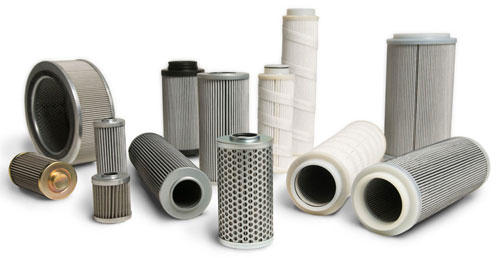There are multiple reasons why fluid can become contaminated. Use and wear of the components, poor plumbing, and contamination brought in with new fluid (or new components) are just a few of the possibilities. This is why no fluid power system can be complete without the use of a filter. Hydraulic filters keep the hydraulic fluid contaminant free.
There are a several types of filters, including: bag, screen, and magnetic. The bag filter consists of a cloth bag which the hydraulic fluid is pushed through, the contaminants (being solid) are unable to flow through the bag as well. This is particularly useful in the filtering of dirt, rust, and particles introduced into the system by a cylinder rod. Screen filters are constructed with many small wires which are woven together to create a metallic cloth. These filters can be constructed to a precise pore size, which allows an engineer to choose the right size for the expected contaminant size. Finally, there are magnetic filters. These filters use magnetically charged plates that will attract any metallic contaminants. The construction of the filter is also an important selection criteria. This covers what is included with the filter and the alignment. When purchasing a filter it is important to know if the system needs a filter with or without the housing. There are a few different alignment options available for filters. When the inlet, outlet, and filter are all lined up this is called an “in-line” alignment. Another alignment is the “off-line” alignment, which is when the filter is not on the main hydraulic systems loop. There is another configuration which is called “duplex”. This configuration is when there are two filters combined together. These filters are useful for maintenance (changing of the filter elements) without disrupting the working system. A “return-line” configuration is designed to catch all contaminants introduced to the system.
A filter’s rating is a measure of its effectiveness. One of these, ISO 4406, is a standard measure of the contaminant level found in a given filter system. An ISO 4406 code is composed of 2-3 numbers, each of which represents a logarithmic measure of the number of contaminants present at 3 set size ranges (4µ,6µ,14µ[c]) in 1 ml of fluid. For example, a new sample of oil might measure 18/15. This corresponds to 1300-2500 particles of 4 microns, and 160-320 particles greater than 14 microns. A filter with a lower ISO cleanliness rating will therefore more thoroughly remove contaminants and can help to prolong the life of the hydraulic system’s components by 2-3 times.
Another measure of filter efficiency is the filter’s beta ratio, which is the ratio of the number of contaminant particles upstream of the filter divided by the number downstream. The beta ratio can be subtracted by 1, divided by the beta ratio and multiplied by 100 to obtain the filter’s percent efficiency for a given contaminant size. When choosing a hydraulic filter, a greater beta ratio is desirable.
Selection criteria
- Flow describes how much fluid flow is permissible through the filter, the maximum flow rate.
- Pressure describes the maximum operating pressure that the filter can withstand.
- Port size is the size of the inlet and outlet ports which need to connect to the hydraulic fluid system.



This is a great explanation of hydraulic filters and the different kinds. Keeping them maintained and replaced according to recommendations will help keep your machinery running at it’s optimum.